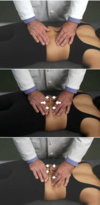BLT/Stills/FPR Flashcards
The method involves the minimization of periarticular tissue load and placement of the affected ligaments in a position of equal tension in all appropriate plans so that the body’s inherent forces can resolve the somatic dysfunction.
BLT
BLT indications
- SDs that involve ligamentous articular strains - areas of lymphatic congestion or local edema
BLT relative contraindications
fractures, open wounds, bony infections, abscesses, DVT, anticoagulation, aortic aneurism
A treatment method in which a dysfunctional body region is addressed with a combination of neutral positioning, application of an activating force (compression, torsion or distraction) and placement into a position of ease.
FPR
FPR indications
myofascial or articular SD
FPR absolute contraindications
unstable fracture, neurological sx manifest during tx, exacerbation of potentially life-threatening symptomatology by tx position
FPR relative contraindications
tx not well tolerated, severe osteoporosis, malignancy, moderate to severe joint instability, spinal stenosis/nerve root impingement
proposed mechanism of FPR
somatic dysfunction is initiated or maintained by increasing activity in the gamma motor neurons of the muscles which stimulate the muscle spindles
inverse spindle output
proposed mechanism of FPR: - positioning the muscle in neutral position eliminates the afferent excitatory input to the spinal cord through group 1a and II fibers - tension and hypertonicity of extrafusal muscle fiber is reset
initial response of FPR is ___ then ____
soft tissue articular
The dysfunctional region is first placed in an indirect position, an axial force (compression, traction, torsion) is added then used to carry the region toward or through the restrictive barrier
Still’s
Still’s indications
SDs in virtually all tissues of the body, including cranium, spine, sacrum, pelvis, limbs, muscles, tendons, ligaments, viscera
Still’s contraindications
recent wounds or fractures less than 6 weeks old
looking at a SD as an impediment to the flow of a river with the goal of treatment being to remove the stone and let the stream flow through unimpeded
BLT
FPR suboccipital hypertonic muscles
- flex head and neck forward - apply gentle axial pressure - while compressing, extend head and neck and SB to side of hypertonic muscles - hold 3-5 seconds




